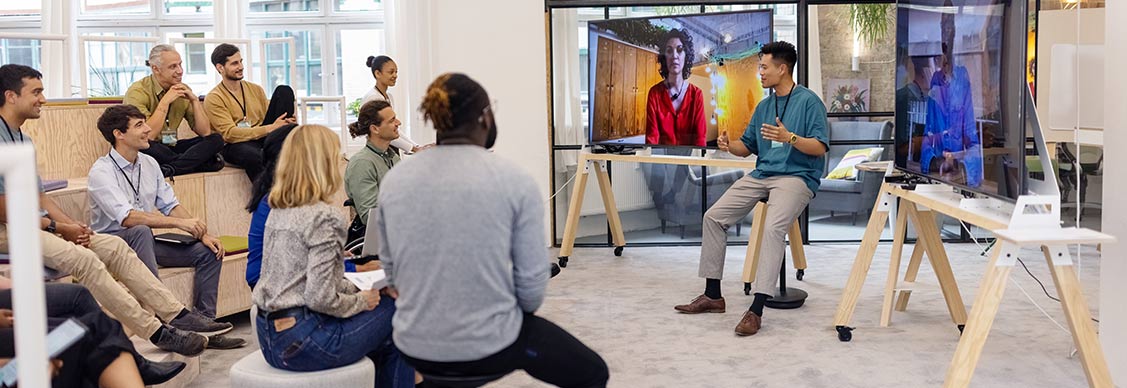How workplace designers are getting people back in the office
Fewer desks, soundproof booths and
a new approach to projects are
enabling hybrid work
How people use the office has changed, and with it the ways that companies have long tracked productivity and built their corporate culture.
This has put leaders under pressure to create experiences for employees that complement, and in some ways even compete with, the comforts of home. As a new balance emerges, office design is witnessing one of the biggest rethinks in decades.
We spoke to Rémi Calvayrac, Head of Work Dynamics France and Head of PDS France, BeNeLux & Nordics at JLL, and Adrian Davidson, EMEA Head of Design at Tétris, to find out how the “hybrid enablement challenge” is affecting the workplace.
What’s the biggest change you’re seeing in the workplace projects that come across your desk?
Rémi Calvayrac: The way we’re approaching projects is what’s changed the most. Previously we worked with specialized teams from one area of the client’s business. But now, managing the processes of stakeholder governance and decision making is more complex. We’re having to bring the whole organization to the table, and do extensive research, to deliver what’s required from a hybrid workplace perspective.
It's all because the office has become a strategic asset. What I mean is that organizations have realized the workplace is not just a fixed overhead and somewhere to put desks.
Adrian Davidson: I agree. Traditionally, departments such as IT, HR, and real estate were quite siloed. But companies have realized it needs to be like an orchestra – we’re playing different instruments, but we’ve all got to be playing the same tune to get the workplace functioning efficiently. Our role is to be the conductor, pulling everything together for the client.
Some firms were early adopters of flexible activity-based models, but COVID-19 fundamentally changed the way people work. Collaborating with both in-person and remote colleagues throughout the day is one of the biggest challenges. To support these seamless transitions to different types of work, we’re creating more dynamic spaces and using technology to support hybrid video meetings.
Levels of comfort and acoustics have also increased in importance. We’re all more sensitive to noise after working at home – so we’re introducing more soundproof booths or pods for calls or focused work.
How are firms redesigning the workplace to offer employees something they can’t get at home?
Rémi Calvayrac: There are so many ways workplaces are changing, although it’s interesting to note that the menu of spaces catering for different types of activities hasn’t changed, but the ratios have.
JLL’s global Occupancy Benchmarking Report found 80% of organizations plan to expand collaboration space. We’re certainly seeing the proportion of fixed desks to collaboration space reversing.
Adrian Davidson: It’s not just the design of the space itself, but the level of service that’s changing to make the commute worthwhile. It's no use demanding people back and then they're sat in isolation pods or with headphones in – companies need a much stronger social strategy.
Facilities managers are adopting an events mentality, rather than just servicing square meters. Companies are finding ways to integrate rituals into the pattern of work. People need to feel they belong, so the physical space becomes important as a place to build bonds, trust, relationships and friendships.
It’s why companies are now asking for more hospitality features – such as bars or baristas with coffee roasting facilities instead of traditional reception areas.
Rémi Calvayrac: The difficulty is there’s no one-size-fits-all across sectors, firms or even regions. Office attendance fluctuates across the week, so rightsizing to ensure people have access to desks and other spaces is hard.
Booking systems have come into play, but spontaneity and impromptu encounters are what differentiate the office from home. Nobody wants to spend their whole day on an app trying to book multiple seats!
Taking a participative approach to understand the needs of your employees and the strategic business objectives is key in setting initial principles. Each situation must be curated to suit – and then constantly monitored, as capacity and utilization evolves over time. That’s where technology really helps.
The role of managers is also changing significantly to bring teams and generations together with purpose and intention, to collaborate, innovate and learn from one another. They’re still on a journey to understand how best to blend physical and remote teams.
What’s next for the future of workplace?
Rémi Calvayrac: Companies are becoming less insular. They’re developing more of a sharing economy that considers social value. They’re seeking connections with local neighborhoods. For example, can we open our restaurant or gym to the public at evenings or weekends? It’s tricky, because of security issues, especially cyber security.
You can see the shift in the investor side, too, with many more mixed-use developments. Adaptability is crucial as we can’t predict the next 30 years, we need to plan for agility.
Adrian Davidson: Certainly there’s more mindfulness of sustainability, not designing spaces for single use and utilization of the circular economy - repurposing buildings, furniture and materials.
Companies have a willingness to be more inventive, they’re starting to engage and open up to show a friendly face to the city and the public. It’s more of a retail mindset that showcases brand.
We’re already working with some clients who want to use private spaces for public benefit and no doubt we’ll see more of that in future.
